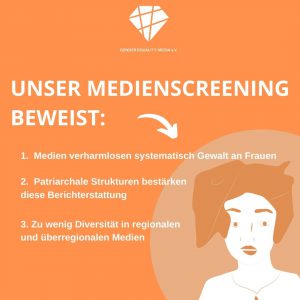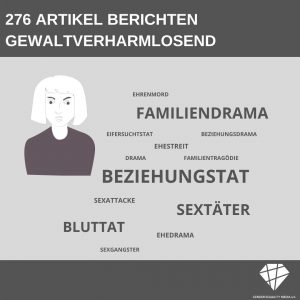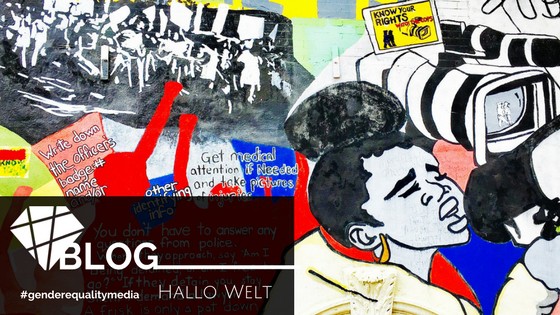92 percent of the articles counted trivialize violence against women
- englisch
- 24.11.2020
The map can be enlarged at the top right (click on the box)
On the International Day for the Elimination of Violence against Women, it is all the more important to take a look at the reporting on violence against women* in the German media in recent months. For the period from September 1 to October 31, we were able to count a total of 115 articles as part of our media screening, with 97% of media coverage using terms that trivialize violence. This means that autumn only differs from summer in terms of the absolute number of articles counted (cf. 142 articles counted), but not in terms of the percentage distribution of reporting that trivializes violence. Just as in the summer months, the most frequently used terms trivializing violence in September and October were blood crime with 33 articles (29%), family drama with 23 articles (20%) and relationship crime with 18 articles (16%). With a total of 18 cases in the last 2 months, we also recorded a high frequency of use of marital dispute compared to the rest of the year – in September alone, the word was used in 19% of reports on violence against women. In these cases, the headline often reads Ehestreit eskaliert – Mann verletzt seine Frau mit Messer or SEK beendet Ehestreit. The absurdity of using, for example, marital dispute against the backdrop of life-threatening and deadly violence by men against women* once again emphasizes the need for an International Day for the Elimination of Violence against Women. The media still far too rarely classify these acts of violence correctly and describe them for what they are: Murders of women or femicides. The numbers speak for themselves: only three articles used femicide / feminicide in September or October. For this reason, we continue to count and are all the louder today, November 25th, because violence against women* is a systemic problem for society as a whole that cannot continue to be ignored.
Update, 1. Oktober 2020: We have now added the media screening results from July and August to our map of Germany on violence against women. Unfortunately, the results of these two months are unsurprising: out of 146 articles screened on violence against women in Germany, 142 cases (97%) used terms that trivialized violence, such as blood crime (52), relationship crime (27) or family drama (20). One case in particular stuck in our minds: On July 22, 2020, the artist Rebeccah Blum was murdered in Berlin by her partner Saul Fletcher, a well-known photographer. Almost all the media coverage preferred to focus on her professional and artistic achievements, while neither Rebeccah Blum’s name nor personal details were mentioned. Even worse, much of the media coverage focused on the even better known, not very close friend of the alleged murderer, Brad Pitt. Apparently we live in a world where the insignificant role of Brad Pitt in the life of an alleged murderer takes up more space than the woman who was murdered. Fittingly, only 3% of the articles screened between July and August drew direct attention to the structural extent of violence against women in this country by using the terms „femicide“ or „murder of women“.

Wrap-up: Six months of media screening, a map of Germany and trivializing reporting
The media regularly trivialize (sexualized) violence against women – every day! Last year, we already investigated reporting on violence against women.However, our algorithm, which we used between October and November 2019 to count the terms and frequency with which the media trivialize (sexualized) violence against women, only included 20 media outlets. We have now changed this: For an even more comprehensive view of the German media landscape, our screening has included all media that can be tracked via Google News since 2020.
The pressure on the media is growing
Our keyword search focuses primarily on reporting on structural violence against women. As in the first six months of this year, our screening will not pause in the second half of the year. In this way, we guarantee the most comprehensive picture possible of developments and trends in the media landscape when it comes to reporting on violence against women. To this end, we are drawing a map of Germany based on the collected articles, which not only allows us to interactively trace the reporting, but also shows the extent to which women in Germany are victims of violence. However, it is crucial for us that we only focus on articles that relate to acts of violence in Germany in 2020. We will continue to update the interactive map of Germany on a monthly basis so that we can take stock at the end of the year.
92% of the articles counted trivialize violence against women in their language
From January 1 to June 30, 2020, we counted a total of 301 articles on acts of violence against women. All of the acts reported were committed in Germany in 2020 only. As in 2019, the disparity between articles that use terms such as „femicide“, „femicide“ or „murder of women“ to explicitly refer to the structural extent of violence against women is immense compared to articles that use terms that trivialize violence. In detail, this means that „femicide“, „femicide“ or „murder of women“ were only used in 24 cases (8%) compared to 277 articles (92%) with terms that trivialize (sexualized) violence.
As the first half of the year was dominated by the COVID-19-related lockdown in all aspects of our lives, this naturally also had an impact on media coverage: reporting on violence against women fell dramatically. In the months of February, March and April, we only counted between 32 (February) and 36 (April) articles reporting on acts of violence against women. Furthermore, reporting between February and April was particularly characterized by concerns that domestic violence against women would increase as a result of the lockdown. We also noticed an increasing number of articles that took a critical look at the use of problematic terms in reporting on violence against women and denounced the associated concealment of this structural problem. Despite a slight increase in the use of „femicide“ and „feminicide“ (April 6x, May 8x and June 3x), we noticed that the number of articles trivializing violence increased more drastically with the end of the lockdown.

The terms used to trivialize (sexualized) violence against women are still particularly popular: „relationship crime“, „family drama“, „blood crime“ and the so-called „sex offender“. These terms not only relegate partner violence to the private sphere (relationship) but also trivialize it as a single act (drama). In addition, the media are particularly good at speculating about the motive for the crime, which usually boils down to jealousy. Jealousy is also firmly anchored as a motive in the judiciary and the police. This not only systematically adopts the perpetrator’s perspective and focuses on male possessiveness, but also makes femicides and the structural extent behind them invisible.
Surprisingly, this time the Bild newspaper was not the leader among the media that most frequently trivialize (sexualized) violence. With 27 hits, this was the regional news portal Tag24, closely followed by Bild, Express and Karlsruhe Insider. This clearly shows that regional media in particular make use of terms that trivialize violence.
We were able to count a total of 16 articles that explicitly refer to the structural extent of violence against women with „femicide“ and 9 articles that use the term „femicide“ or „murder of women“. Among the pioneers in reporting, anf deutsch, Potsdamer Neuste Nachrichten, Frankfurter Neue Presse and Perspektive online were particularly prominent. Nevertheless, the use of terms such as „murderer of women“ does not necessarily guarantee appropriate reporting on violence against women: This is especially the case when the media use female murders as infotainment and the reporting resembles a crime story.
The media make a significant contribution to shaping public opinion. We therefore call for responsible reporting by all journalists when it comes to systematic violence against women. Our map of Germany shows very clearly that femicides, (attempted) rapes and sexual harassment are not isolated cases in Germany, but that there is a system behind them. So if journalists can speculate about motives for crimes, why not take the plunge and speculate about whether there might be a structural problem behind all the femicides and murders of women? Why not mention toxic images of men, sexist images of women and social power and gender relations? And why not just talk about „femicides“, „femicides“ or „rapists“ instead of „sex offenders“?





